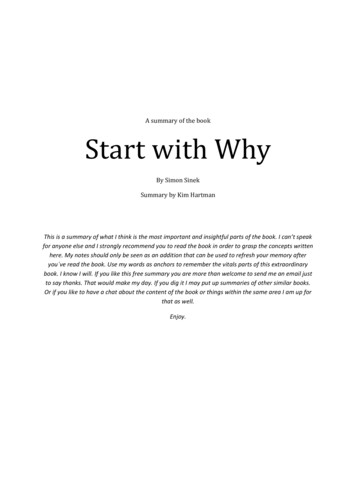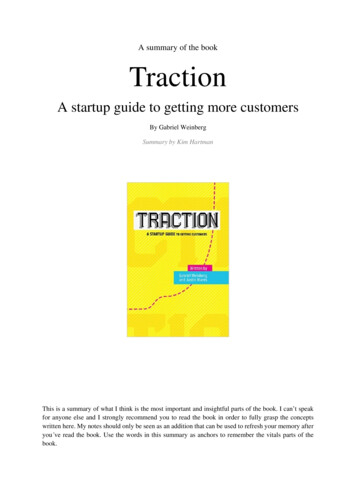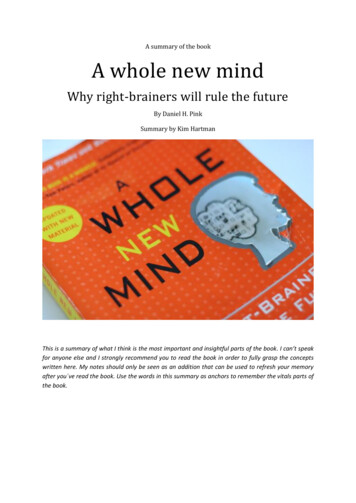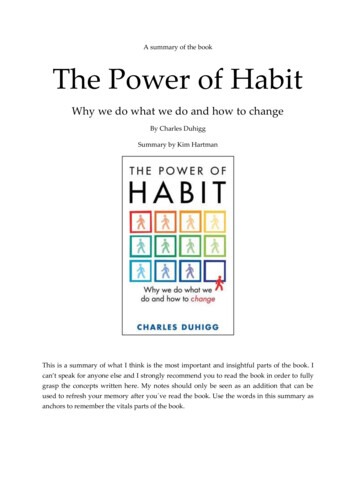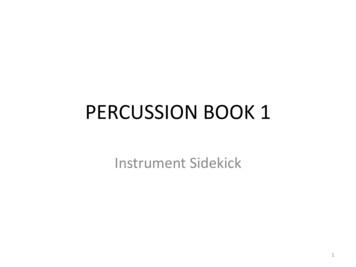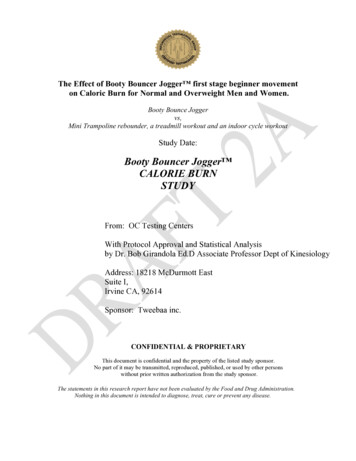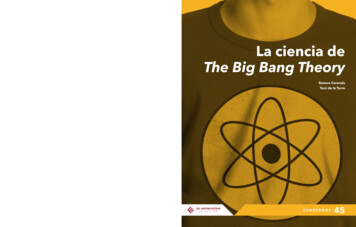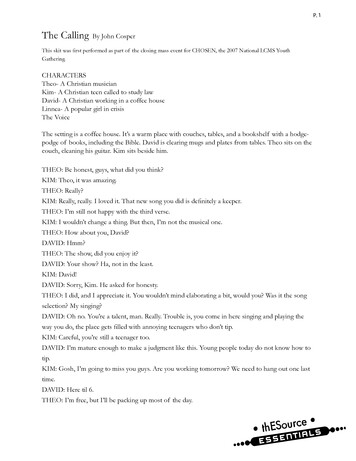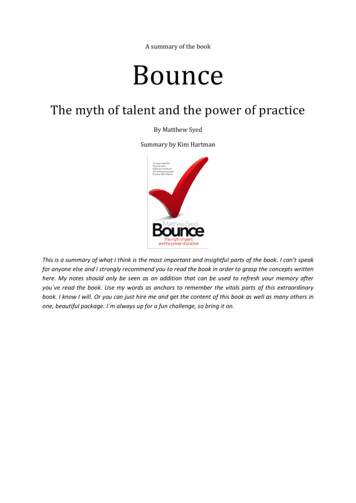
Transcription
A summary of the bookBounceThe myth of talent and the power of practiceBy Matthew SyedSummary by Kim HartmanThis is a summary of what I think is the most important and insightful parts of the book. I can’t speakfor anyone else and I strongly recommend you to read the book in order to grasp the concepts writtenhere. My notes should only be seen as an addition that can be used to refresh your memory afteryou ve read the book. Use my words as anchors to remember the vitals parts of this extraordinarybook. I know I will. Or you can just hire me and get the content of this book as well as many others inone, beautiful package. I m always up for a fun challenge, so bring it on.
More book summaries at www.kimhartman.seContact me at Kim.hartman@hyperisland.seFollow me on Twitter & Instagram @tjimmContentsDescription from amazon . 2Chapter 1: The hidden logic of success . 3Chapter 2: Miraculous children? . 5Chapter 3: The path to excellence . 6Chapter 4: Mysterious sparks & life-changing mindsets . 9Chapter 5: The placebo effect . 11Chapter 6: The curse of choking and how to avoid it. 12Chapter 7: Baseball rituals, pigeons, and why great sportsmen feel miserable after winning. 13Chapter 8: Optical illusions and X-ray vision . 14Chapter 10: Are black’s superior runners? . 151
More book summaries at www.kimhartman.seContact me at Kim.hartman@hyperisland.seFollow me on Twitter & Instagram @tjimmDescription from AmazonEssential reading following an astounding summer of sport; if you’ve ever wondered what makes achampion, Bounce has the answer.What are the real secrets of sporting success, and what lessons do they offer about life? Why doesn’tTiger Woods “choke”? Why are the best figure skaters those that have fallen over the most and whyhas one small street in Reading produced more top table tennis players than the rest of the countryput together.Two-time Olympian and sports writer and broadcaster Matthew Syed draws on the latest inneuroscience and psychology to uncover the secrets of our top athletes and introduces us to anextraordinary cast of characters, including the East German athlete who became a man, and herhusband – and the three Hungarian sisters who are all chess grandmasters. Bounce is crammed withfascinating stories and statistics.Looking at controversial questions such as whether talent is more important than practice, drugs insport (and life) and whether black people really are faster runners, the mind-bending Bounce is amust-read for the hardened sports nut or brand new convert.2
More book summaries at www.kimhartman.seContact me at Kim.hartman@hyperisland.seFollow me on Twitter & Instagram @tjimmChapter 1: The hidden logic of successThe delusion lies in focusing on the individuality of their triumph without perceiving – or bothering tolook for – the powerful opportunities stacked in their favor.Ericson’s experiment: purposeful practice was the only factor distinguishing the best from the rest. Itis practice, not talent that ultimately matters.Experiment with British music students: hour for hour, the various groups had improved with almostidentical rates. The difference was simply that top performers had practiced for more hours.A minimum of ten years is required to reach world-class status in any complex task.Gladwell: most top performers practice for around 10 000 hours per year (it is difficult to sustain thequality of training if you go beyond that).An arbitrary difference in birth date sets in train a cascade of consequences that, within a matter of afew years, has created an unbridgeable chasm between those who, in the beginning, were equallywell equipped for sporting stardom.The iceberg illusion by Ericsson: when we witness extraordinary feats of memory (or of sporting orartistic prowess) we are witnessing the end product of a process measured in years. What is invisiblefor us – the submerged evidence, as it were – is the countless hours of practice that have gone intothe making of the virtuoso performance.Anybody can achieve the same results with opportunity and dedication.Retrieval structure: make sense of numbers and words and put them in a context. 3 4 9 2 can bethought of as 3 minutes and 49,2 seconds, a time for running a marathon.In a nutshell, when chess masters look at the positions of the pieces on a board, they see theequivalent of a word. Their long experience of playing chess enables them to “chunk” the patternwith a limited number of visual fixations in the same way that our familiarity with language enablesus to chunk the letters constituting a familiar word. It is a skill derived from years of familiarity withthe right “language”, not talent. (p. 24)It’s not as simple as just knowing about where to look; it is also about grasping the meaning of whatyou are looking at. It is about looking at the subtle patterns of movement and postural clues andextracting information. Think about a tennis player that looks at the trunk and hips of theiropponents on return in order to pick up the visual clues governing where they are going to serve.Recognition of familiar scenarios and the chunking of perceptual information into meaningful wholesand patterns speed up processes.Speed in sport is not based on innate reaction speed but derived from highly specific practice.The limiting factor in making a world-class stroke isn’t strength or brute force, but the executivecontrol of fine motor movement to create perfect timing.3
More book summaries at www.kimhartman.seContact me at Kim.hartman@hyperisland.seFollow me on Twitter & Instagram @tjimmFederer has practiced for so long that the movement have been encoded in implicit rather thanexplicit memory. This is what psychologists call expert-induced amnesia.The most important differences are not at the lowest levels of cells or muscle groups, but at theathlete’s superior control over the integrated and coordinated actions of their bodies. Expertperformance is mediated by acquired mental representations that allow the experts to anticipate,plan and reason alternatives courses of action. (p.35)It is practice, not talent that holds the key to success.Study on decision-making in the real world: The curious thing was not that top-decision makers likefirefighters and doctors were making choices based on unexpected favors; it was that they did notseem to be making choices at all.Expert firefighters are able to confront a burning building and almost instantly place it within thecontext of a rich, detailed, and elaborate conceptual scheme derived from years of experience. Theycan chunk the visual properties of the scene and comprehend its complex dynamics, often withoutunderstanding how. This is extrasensory perception, a sixth sense.What they all have in common is long experience and deep knowledge.Knowledge-free computing, however sophisticated, is impotent. The most important ingredient in anexpert system is knowledge. Programs that are rich in general inference methods – some of whichmay even have some of the power of mathematical logic – but poor in domain-specific knowledgecan behave expertly on almost no tasks.Expert knowledge simply cannot be taught in the classroom over the course of a rainy afternoon.Sure, you can offer pointers of what to look for and what to avoid, and these can be helpful. Butrelating the entirety of the information is impossible because the cues being processed by experts –in sports or elsewhere – are so subtle and relate to each other in such complex ways that it wouldtake forever to codify them in their mind-boggling totality. This is known as combinatorial explosion.Good decision-making is about compressing the informational load by decoding the meaning ofpatterns derived from experience. This cannot be taught in a classroom; it must be lived and learned.It emerges through practice.Expertise is a long-term development process, resulting from rich instrumental experiences in theworld and extensive practice.To be successful, a chess player must cut down on the computational load by ignoring moves unlikelyto result in a favorable outcome and concentrating on those with greater promise. Kasparov is ableto do this by understanding the meaning of game situations. Deep Blue (the chess computer) is not.An example of circumventing explosion via advanced pattern recognition: Gretzky can discern thegames underlying pattern and flow, and anticipate what’s going to happen faster than anyone else inthe building. Several times during game you’ll see hi making what seem to be aimless circles on theother side of the rink from the traffic, and then, as if answering a signal, hell dart ahead to a spotwhere, an instant later, the puck turns up.4
More book summaries at www.kimhartman.seContact me at Kim.hartman@hyperisland.seFollow me on Twitter & Instagram @tjimmChapter 2: Miraculous children?Child prodigies amaze us because we compare them not with other performers who have practicedfor the same length of time, but with children of the same age who have not dedicated their lives inthe same way.Extensive research has shown that there is a scarcely a single top performer in any complex task whohas circumvented the ten years of hard work necessary to reach the top.A young performer has a sizeable head start on anybody who commences their training a few yearslater.It is only possible to clock u meaningful practice if an individual has made an independent decision todevote himself to whatever field of expertise. He has to care about what he is doing, not because aparent or a teacher says so, but for its own sake. This is called internal motivation.The only circumstances in which very early development seem to work is where the childrenthemselves are motivated to clock up the hours, rather than doing so because of parents or a coach.The key is to be sensitive to the way the child is thinking and feeling, encouraging training withoutexerting undue pressure.The dangers of starting out to hard, too young, often outweigh the benefits. One of the skills of agood coach is to tailor a training program to the mindset of the individual.Onlookers took the performance to be the consequence of special abilities because they hadwitnessed only a tiny percentage of the activity that had gone into its making.There is no evidence for differences in innate specific capacities for mathematics.5
More book summaries at www.kimhartman.seContact me at Kim.hartman@hyperisland.seFollow me on Twitter & Instagram @tjimmChapter 3: The path to excellenceWe do our jobs, but often with our minds absent – partially or wholly – from what we are doing. Wego through the motions. This is why length of time in many occupations is only weakly related toperformance. Mere experience, if it is not matched by deep concentration, does not translate intoexcellence. “I have not improved in five years. Why? Because I have been cruising on autopilot”.Anagrams: words where letters have been mixed. With difficult anagrams the jumble of letters forceyou to do something tan other than breeze through. You have to stop for a moment and think andyou are forced to click out of autopilot. In those few seconds of striving, the word is imprinted onyour memory.Ericsson: when most people practice, they focus on the things that they can do effortless. Expertpractice is different. It entails considerable, specific and sustained efforts to do something you can’tdo well – or even at all. It is only by working on what you can’t do that you turn into the expert youwant to become.Purposeful practice: the practice sessions of aspiring champions have a specific and never-changingpurpose: progress. Every second of every minute of every hour, the goal is to extend one s mind andbody, to push oneself beyond the outer limits of ones capacities, to engage so deeply in the task thatone leaves the training session, literally, a changed person.World class performance comes by striving for a target just out of reach, but with a vivid awarenessof how the gap might be breached. Over time, through constant repetition and deep concentration,the gap will disappear, only for a new target to be created, just out of reach again.Purposeful practice s about striving what’s just out of reach and not quite making it; it is aboutgrappling with tasks beyond the current limitations and falling short again and again. Excellence isabout stepping outside the comfort zone, training with a spirit of endeavor, and accepting theinevitability of trials and tribulations. Progress is built, in effect, upon the foundations of necessaryfailure. That is the essential paradox of expert performance.“Landing on your ass twenty thousand times is where great performance comes from”.China and Ping-Pong, Brazil and soccer; all the successful systems have one thing in common: theyinstitutionalize the principles of purposeful practice.What is required is ten thousand hours of purposeful practice. And for practice to be trulypurposeful, concentration and dedication, although important, are not sufficient. You also need tohave access to the right training system, and that sometimes means living in the right town or havingthe right coach.Anders Ericsson: The body and mind can be radically altered with the right kind of practice. Whenthe body is put under exceptional strain, a range of dominant genes in the DNA are expressed andextraordinary psychological processes are activated. PP. 85A key aspect of brain transformation is myelin, a substance that wraps around the nerve fibers andthat can dramatically increase the speed with which signals pass through the brain.6
More book summaries at www.kimhartman.seContact me at Kim.hartman@hyperisland.seFollow me on Twitter & Instagram @tjimmPurposeful practice also builds new neural connections, increase the size of specific sections of thebrain, and enables the expert to co-opt new areas of grey matter in the quest to improve.The very process of building knowledge transforms the hardware in which the knowledge is storedand operated.Automaticity: When we learn a new task, like driving a car, we concentrate hard to master the skills.At first we are slow and awkward, and our movements are characterized by conscious control, but aswe get more familiar, the skills are absorbed in implicit memory, and we no longer give muchthought to them.Purposeful practice is transformative.Creative innovation: J-O transformed the service action in table tennis by holding the bat betweenthumb and forefinger, dramatically increasing flexibility and spin. Dick Fosbury broke the worldrecord for high jump with a new style in which he took off from the outside foot before sailing overthe bar headfirst and with his back facing downwards. Where do these paradigm shifts comes from?How do these creative leaps, which transform performance by circumventing seemingly immovableconstraints, emerge?Creative innovation follows a very précis pattern: like excellence itself, it emerges from the rigors ofpurposeful practice. It is the consequence of experts absorbing themselves for so long in their chosenfield that they become, as it were, pregnant with creative energy. To put it another way, eurekamoments are not lightning bolts from blue, but tidal waves that erupt following deep immersion inan area of expertise.The ten years rule of creativity: What seems lie pure, untainted mystical creativity is, in fact, theconsequence of lifetime devotion.When creativity manifests itself not in artistic expression but in technical innovation, a subtle butimmensely powerful interaction is created: purposeful practice changing individuals, and alsochanging the means of changing individuals. In stage one, experts engage in purposeful practice and,as a consequence, develop new techniques. In stage two, other individuals corral these innovationsto increase the efficacy of practice, leading to new innovations in stage three, and so on.The perfect conditions for feedback: by creating a perfectly reproducible stroke, I was able to instantidentify what had gone wrong when I made a mistake, leading to automatic refinement andreadjustment. If you don’t know what you are doing wrong, you can never know what you are doingright. We need to know where we are going wrong if we are going to improve.Feedback is the rocket fuel that propels the acquisition of knowledge, and without it no amount ofpractice is going to get you there.Jack Nicklaus always created a clear idea of precisely what he wanted to achieve on every shot:“I never hit a shot, even in practice, without having a very sharp, in-focus picture of it in my head. It’slike a color movie. First I see the ball where I want to finish, nice and white and sitting up high on the7
More book summaries at www.kimhartman.seContact me at Kim.hartman@hyperisland.seFollow me on Twitter & Instagram @tjimmbright green grass. The scene quickly changes and I see the ball going there; its path, trajectory, andshape, even its behavior on landing.”By comparing the outcome of the shot with the color movie of his intention, he was able to learn andadapt in the most efficient way on every single stroke he ever played.Great coaches are able to design practice so that feedback is embedded in the drill, leading toautomatic readjustment, which in turn improves the quality of feedback, generating furtherimprovements, and so on.The evolutionary process: an evolutionary mutation is tested against the feedback of survival andreproduction, which in turn permits new mutations, which are tested once again, and so on. After afew hundred million years in this feedback loop, single-cell organisms have evolved into modernhumans and the other wondrous species we see around us.The talent theory is not merely flawed in theory; it is insidious in practice, robbing individuals andinstitutions of the motivation to change themselves and the society. Expertise is ultimately about thequality and quantity of practice.8
More book summaries at www.kimhartman.seContact me at Kim.hartman@hyperisland.seFollow me on Twitter & Instagram @tjimmChapter 4: Mysterious sparks & life-changing mindsetsTransformational moment: Shaq O’Neill was about to quite basket, telling his mom that he could doit later. His mom responded: Later doesn’t always come to everybody.Clocking up thousands of hours of purposeful practice ultimately determines how far we make italong the path to excellence: but it is only those who care about the destination, whose motivation isinternalized, who are ever going to get there.Motivational jolts: A group of student was divided into two parts. One part were given a small detailthat could be associated to themselves when studying a report of a person – such as that the personhade the exact me birth date as the students. The motivational level showed to go sky high for thestudents who had the same birthday.These events are so powerful because they are small and indirect. It is called motivation byassociation; a small, barely noticed connection searing deep into the subconscious and sparking amotivational response.The need to belong, to associate, is among the most important human motives. We are almostcertainly hardwired with a fundamental motivation to maintain these associations.Dwecks experiment: those students who held the belief that intelligence is set in genetic stone (thetalent myth) were labeled as having a fixed mindset. Those who believed that intelligence can betransformed through effort were labeled as having a growth mindset.The figure skater champion fell and fell. Why did she not give up? Because she did not interpretfalling down as failure. Armed with a growth mindset, she interpreted falling down not merely as ameans of improving, but as evidence that she was improving. Failing provided her with anopportunity to learn, develop and adapt.Edison: if I find 10 000 ways something won’t work, I haven’t failed. I am not discouraged, becauseevery wrong attempt discarded is another step forward.Examples of talent-oriented shitheads: You learned that so quickly, you are so smart MEANS If I don’t learn something quickly, I mnot smart.You are so brilliant; you got an A without really studying MEANS I d better quit studying orthey won’t think I’m brilliant!So:We should praise effort, not talent we should emphasize how abilities can be transformed throughapplication; we should teach others and ourselves to see challenges as learning opportunities ratherthan threats; we should interpret failure not as an indictment but as an opportunity.World-class performers emerge from mindset. Perhaps the key of any institution is to encourage theadoption of a growth mindset.9
More book summaries at www.kimhartman.seContact me at Kim.hartman@hyperisland.seFollow me on Twitter & Instagram @tjimmKnight, the table tennis player that started to go backwards but got back on track: The growthmindset permeates his attitude not merely to table tennis but to life; his relationships, hiscommitments, his responsibilities to friends, teammates, and sponsors. He does not duck challenges,and he doesn’t regard failure as a reason to stop striving.10
More book summaries at www.kimhartman.seContact me at Kim.hartman@hyperisland.seFollow me on Twitter & Instagram @tjimmChapter 5: The placebo effectBelieving in something beyond the self can have a hugely beneficial psychological impact, even if thebelief is fallacious.The thing that often separates the best from the rest is a capacity to believe thing that are not truebut which are incredible effective.The example with the slider who got a salt water injection instead of morphine: the solder was notmerely comforted by the injection of saltwater; he was able to tolerate the agonies of surgery as wellas if he had been injected with real anesthetics.The key point is that the power of the mind is exercised through the medium of belief, and it doesn’tmatter whether the belief is true or false, or how the delusion is created, so long as it is createdsuccessfully.The placebo effect: it is the belief itself, not its content that matters.If you expect the best, you are given some strange kind of power to create the conditions thatproduce the desired results.The difference between world-class performers and mediocre performers are that they take thesemental manipulations to greater extremes. They have taught themselves to ratchet up theiroptimism at the point of performance; to mould the evidence to fit their beliefs rather than the otherway around; to activate doublethink.11
More book summaries at www.kimhartman.seContact me at Kim.hartman@hyperisland.seFollow me on Twitter & Instagram @tjimmChapter 6: The curse of choking and how to avoid itChoking is a species of failure so absolute that it looks as if there is an entirely different player out onview.It is one aspect of choking that is universal: it only ever occurs under conditions of sever pressure.Expert-induced amnesia: James has automated his stroke-making. Many hours of practice haveenabled him to encode the stroke in implicit rather than explicit memory.The migration from the explicit to the implicit system of the brain has two crucial advantages. First, itenables the expert player to integrate the various parts of a complex skill into one fluent whole,something that would be impossible at a conscious level because there are too many interconnectingvariables for the conscious mind to handle.Example of the transition between brain systems: when you learn to drive a car. Starting out, youhave to focus on all the separate things; gears, brake etc. After you have been driving for a while,things have changed. Your skills have moved from the explicit to the implicit, from the conscious tothe unconscious, and your ability has graduated from novice level to proficiency.But think if an expert were to find himself using the wrong brain system. No matter how great he is,he would strive because he is using his explicit rather than internal system. The highly sophisticatedskills encoded in the implicit part of his brain would count for nothing.When the brain switch occurs, neither courage nor cowardice makes the least bit difference. Chokingis a problem of psychological reversion: the flipping from a brain system used by experts to one usedby novices.On simple tasks, the tendency to slow down and take conscious control confers huge advantages.But precisely the opposite applies when executing a complex task. When doing a shot, a tennis prowho has direct attention towards the mechanics of the shot is likely to be catastrophic because thereare too many interconnecting variables for the conscious mind to handle. Choking, then, is a kind ofneural glitch that occurs when the brain switches to a system of explicit monitoring in circumstanceswhen it ought to stick to the implicit system.It is only an expert performer – someone who has practiced long enough to automate skill – who hasthe capacity to choke. For a novice – still wielding the explicit system – any additional attention islikely to benefit execution, not hinder it.If the performer doesn’t feel any pressure, there is no pressure – and the conscious mind will notattempt to wrestle control from the implicit system.12
More book summaries at www.kimhartman.seContact me at Kim.hartman@hyperisland.seFollow me on Twitter & Instagram @tjimmChapter 7: Baseball rituals, pigeons, and why great sportsmenfeel miserable after winningThe experiment with the pigeons: the pigeons witnessed a random connection between a particularkind of behavior and a desired connection, and wrongly inferred that the relationship was causal.The caveman: A tendency to perceive causal connections that don’t actually exist can confer hugeevolutionary benefits, providing a cocoon of safety in a turbulent and dangerous world. The onlyproviso is that your superstitions must not impose too much of a burden on those occasions whenthey are without foundations.Robert Louis Stevenson: To travel hopefully is better than arriving.Many emotions are universal: hardwired into the brain at birth rather than learned through contactwith any particular culture. Why? Because they are evolved traits rather than cultural creations,designed by natural selection to facilitate survival and gene propagation. Our common emotionalheritage binds humanity together in a way that transcends cultural differences.Anticlimax: we might feel miserable after a triumph. This is so that we are able to disengage fromour triumph, enabling us to focus on the next challenge. If goal fulfillment induced indefinite periodsof contentment, we would be robbed of all future motivation. For an award-winning writer, it is themelancholy hat provides the creative impetus for the next literary adventure.13
More book summaries at www.kimhartman.seContact me at Kim.hartman@hyperisland.seFollow me on Twitter & Instagram @tjimmChapter 8: Optical illusions and X-ray visionThe information that is provided through our eyes and ears are only loosely connected to the way weexperience the world.When we listen to a conversation in our own language, we hear a series of distinct words separatedby tiny gap of silence. But no such silence actually exists. It is our knowledge of the grammaticalstructure of our language that enables us to retouch the acoustic information so that we hear it in aneatly structured form.The key point in all this is that knowledge is not used merely to make sense of perceptions;knowledge is embedded in perceptions.A key difference between experts and novices is that experts are better at extracting informationfrom what’s going on around them. Federer can anticipate the movements of a tennis ball moreefficiently that the rest of us, not because he has better eyesight but because he know where to lookand how to interpret the movement pattern of his opponent.Over time we have developed the ability to sculpt perceptions using top-down knowledge; itprovides immediacy. Instead of having to infer the existence of a face in a pattern of dots or thestructure in mammogram, you can see it. It is there. The inference is, as it were, embedded inperception.Attention is a resource with severe capacity limitations. Most of us have the same bandwidthavailable for conscious processing, but experts, by automating perceptual and motor programs, areable to create spare capacity.(Example at p.217)14
More book summaries at www.kimhartman.seContact me at Kim.hartman@hyperisland.seFollow me on Twitter & Instagram @tjimmChapter 10: Are black’s superior runners?Small populations have genetic traits that are often different from those of other populations; theshort-limbed Inuit, for example, are different from aborigines.The notion of race is so deeply embedded within the human psyche that there is collective blind spotwhen it comes to its use and meaning. We automatically put people of dark skin in a box markedblack people, and assume that any trait shared by some is shared by all.For those genes that there is variation, the vast majority of that variation – around 85 % - existsbetween individuals within population groups.Seeing is not bel
A summary of the book Bounce The myth of talent and the power of practice By Matthew Syed Summary by Kim Hartman This is a summary of what I think is the most important and insightful parts of the book. I can't speak for anyone else and I strongly recommend you to read the book in order to grasp the concepts written
